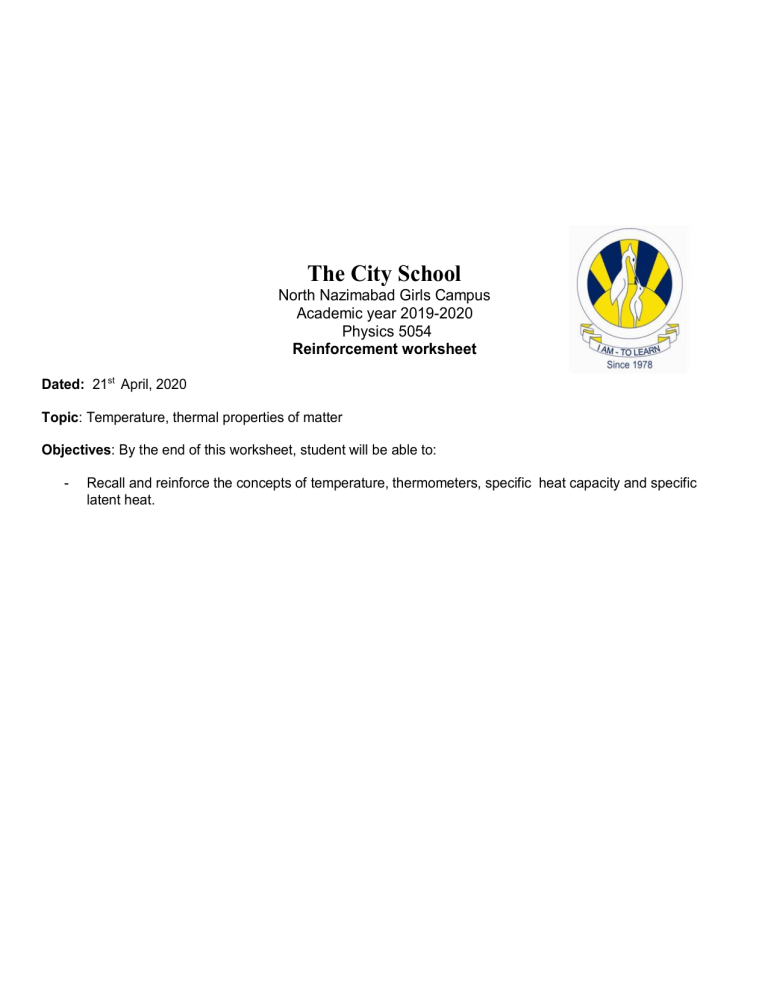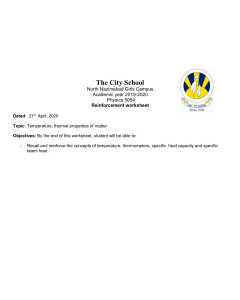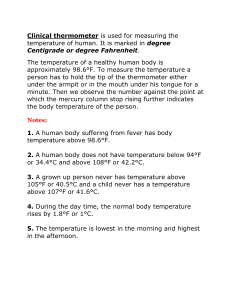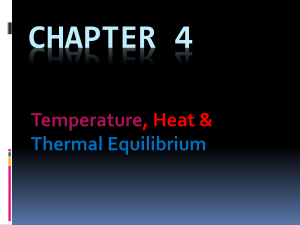
The City School North Nazimabad Girls Campus Academic year 2019-2020 Physics 5054 Reinforcement worksheet Dated: 21st April, 2020 Topic: Temperature, thermal properties of matter Objectives: By the end of this worksheet, student will be able to: - Recall and reinforce the concepts of temperature, thermometers, specific heat capacity and specific latent heat. 1 (a) The source of solar energy is the Sun. Tick the box next to those resources for which the Sun is also the source of energy. coal geothermal hydroelectric nuclear wind [2] (b) Fig. 4.1 shows a solar water-heating panel on the roof of a house. copper tubes, painted black roof Fig. 4.1 Cold water flows into the copper tubes, which are heated by solar radiation. Hot water flows out of the tubes and is stored in a tank. (i) Explain why the tubes are made of copper and are painted black. ........................................................................................................................................... ........................................................................................................................................... .......................................................................................................................................[2] (ii) In 5.0 s, 0.019 kg of water flows through the tubes. The temperature of the water increases from 20 °C to 72 °C. The specific heat capacity of water is 4200 J / (kg °C). Calculate the thermal energy gained by the water in 5.0 s. thermal energy = .......................................................... [3] (iii) The efficiency of the solar panel is 70%. Calculate the power of the solar radiation incident on the panel. power = ........................................................... [2] [Total: 9] 2 (a) State what is meant by the specific heat capacity of a substance. ................................................................................................................................................... ................................................................................................................................................... .............................................................................................................................................. [2] (b) A student carries out an experiment to find the specific heat capacity of aluminium. He uses an electric heater and a thermometer, inserted into separate holes in an aluminium block. The following data are obtained. mass of aluminium block = 2.0 kg power of heating element = 420 W time of heating = 95 s initial temperature of block = 19.5 °C final temperature of block = 40.5 °C Calculate the value of the specific heat capacity of aluminium given by this experiment. specific heat capacity = ................................................. [4] (c) In the experiment in (b), no attempt is made to prevent loss of thermal energy from the surfaces of the block. Suggest two actions the student could take to reduce the loss of thermal energy from the surfaces of the block. 1. .............................................................................................................................................. 2. .............................................................................................................................................. [2] [Total: 8] 3 (a) Fig. 4.1 shows a device used as a thermocouple thermometer. meter Z wire of material X wire of material X wire of material Y Fig. 4.1 In the table put three ticks against the correct statements about the thermocouple thermometer. Meter Z measures energy. Meter Z measures potential difference. Meter Z measures power. Materials X and Y are different materials. Materials X and Y are the same material. Materials X and Y are electrical conductors. Materials X and Y are electrical insulators. [3] (b) A liquid-in-glass thermometer is replaced by a similar thermometer with a larger bulb. No other change is made. State and explain the effect on the sensitivity. ................................................................................................................................................... ................................................................................................................................................... ...............................................................................................................................................[2] (c) The capillary of a liquid-in-glass thermometer should have a constant diameter. Fig. 4.2 shows the capillary of a thermometer made with a manufacturing fault. walls of non-uniform capillary glass bulb capillary Fig. 4.2 (not to scale) State and explain the effect of this fault on the linearity of the thermometer. ................................................................................................................................................... ................................................................................................................................................... ...............................................................................................................................................[2] [Total: 7] 4 A liquid-in-glass thermometer has a linear scale and a range of 120 °C. (a) State what is meant by a linear scale. ................................................................................................................................................... ...............................................................................................................................................[1] (b) The highest temperature that this thermometer can measure is 110 °C. State the lowest temperature that it can measure. lowest temperature = ........................................................... [1] (c) A second liquid-in-glass thermometer has the same range but it has a greater sensitivity. Suggest two ways in which the second thermometer might differ from the first. 1. ............................................................................................................................................... 2. ............................................................................................................................................... [2] (d) A thermometer has a bulb that is painted white and is shiny. It is placed in boiling water for several minutes. It is then removed from the water and is held in air. Fig. 4.1 shows how the thermometer reading changes during the next 8 minutes. 100 temperature / C 80 60 40 20 0 0 2 6 8 time / minutes Fig. 4.1 The bulb of this thermometer is now re-painted so that it has a matt, black surface. The procedure is repeated. (i) On Fig. 4.1, sketch a second line to suggest how the reading of the re-painted thermometer changes during the 8 minutes. [2] (ii) Tick one of the boxes to show how painting the bulb black affects the linearity of the scale, the range and the sensitivity of the thermometer. The linearity, the range and the sensitivity all change. Only the linearity and the range change. Only the linearity and the sensitivity change. Only the range and the sensitivity change. Only the linearity changes. Only the range changes. Only the sensitivity changes. None of these properties changes. [1] [Total: 7] 5 (a) State what is meant by the specific latent heat of fusion (melting) of a substance. ................................................................................................................................................... ...............................................................................................................................................[2] (b) Ice cubes of total mass 70 g, and at 0 °C, are put into a drink of lemonade of mass 300 g. All the ice melts as 23 500 J of thermal energy transfers from the lemonade to the ice. The final temperature of the drink is 0 °C. (i) Calculate the specific latent heat of fusion for ice. specific latent heat of fusion = ...........................................................[2] (ii) The thermal energy that causes the ice to melt is transferred from the lemonade as it cools. The loss of this thermal energy causes the temperature of the 300 g of the lemonade to fall by 19 °C. Calculate the specific heat capacity of the lemonade. specific heat capacity = ...........................................................[2] (iii) The melting ice floats on top of the lemonade. Explain the process by which the lemonade at the bottom of the drink becomes cold. ........................................................................................................................................... ........................................................................................................................................... .......................................................................................................................................[2] [Total: 8] 6 (a) An object of mass m and specific heat capacity c is supplied with a quantity of thermal energy Q. The temperature of the object increases by . Write down an expression for c in terms of Q, m and . c =........................................................... [1] (b) Fig. 4.1 shows the heating system of a hot water shower. power supply cold water in hot water out heating element Fig. 4.1 Cold water at 15 °C flows in at the rate of 0.0036 m3 / minute. Hot water flows out at the same rate. (i) Calculate the mass of water that passes the heating element in one minute. The density of water is 1000 kg / m3. mass = ........................................................... [2] (ii) The power of the heating element is 8.5 kW. Calculate the temperature of the hot water that flows out. The specific heat capacity of water is 4200 J /(kg °C). temperature = .......................................................... [4] [Total: 7] 7. Solar panels are used to heat water. (a) The energy absorbed by solar panels comes from the Sun. (i) Describe how this energy is produced inside the Sun. ........................................................................................................................................... ........................................................................................................................................... ..................................................................................................................................... [2] (ii) State how this energy is transferred to Earth. ..................................................................................................................................... [1] (b) Explain why solar panels are usually black. ................................................................................................................................................... ................................................................................................................................................... ................................................................................................................................................... ............................................................................................................................................. [2] [Total: 5] 8.. In many countries, solid salt is produced by trapping sea-water in large, shallow ponds and letting the water evaporate. Fig. 4.1 shows salt being produced in this way. Fig. 4.1 (a) State two ways in which evaporation differs from boiling. 1. ............................................................................................................................................... ................................................................................................................................................... 2. ............................................................................................................................................... ................................................................................................................................................... [2] (b) Describe, in terms of water molecules, what is happening as the water evaporates. ................................................................................................................................................... ................................................................................................................................................... ............................................................................................................................................. [2] (c) (i) State why the ponds used in this process have large surface areas. ........................................................................................................................................... ..................................................................................................................................... [1] (ii) State why this method of salt production does not work well in a country with a cold climate. ........................................................................................................................................... ..................................................................................................................................... [1] [Total: 6] 9. Fig. 9.1 shows a boiling liquid at its boiling point, trapped in a cylinder by a piston. cylinder piston electric heater gas power supply boiling liquid Fig. 9.1 There is an electric heater in the liquid which is connected to a power supply. The thermal energy produced by the heater gradually turns the boiling liquid into a gas. (a) State what is meant by boiling point. ................................................................................................................................................... ............................................................................................................................................. [2] (b) Explain, in terms of molecules, why it is necessary to supply energy in order to turn a liquid at its boiling point into a gas. ................................................................................................................................................... ................................................................................................................................................... ................................................................................................................................................... ............................................................................................................................................. [3] (c) In order to determine the power of the electric heater, two meters are connected into the circuit. One meter measures the current in the heater and the other meter measures the potential difference (p.d.) across it. On the circuit in Fig. 9.1, draw symbols to show the two meters used and where they are connected. [2] (d) The current in the heater is 2.0A and the p.d. across it is 6.0 V. (i) Calculate the power of the heater. power = ...........................................................[2] (ii) Calculate the thermal energy supplied to the liquid by the heater in 1.0 minute. energy = ...........................................................[2] (iii) The specific latent heat of vaporization of the liquid is 9.0 × 105 J / kg. Calculate the mass of liquid that vaporizes every minute. mass = ...........................................................[2] (e) The piston is free to move in the cylinder. As the liquid boils, the piston is pushed upwards in the cylinder at a constant speed. The volume occupied by the gas just above the liquid increases. Discuss whether the upward force on the piston changes as the piston moves upwards at constant speed. ................................................................................................................................................... ................................................................................................................................................... ................................................................................................................................................... ............................................................................................................................................. [2] [Total: 15] 10. A saucepan of water is placed on an electric hotplate and the water is brought to the boil. As the water boils, it changes from a liquid into a gas. (a) Describe, in terms of the molecules, three ways in which a gas differs from a liquid. 1. ............................................................................................................................................... ................................................................................................................................................... 2. ............................................................................................................................................... ................................................................................................................................................... 3. ............................................................................................................................................... ................................................................................................................................................... [3] (b) In order to keep the liquid boiling, it is necessary to keep the hotplate switched on. Explain why energy must be supplied in order to turn a liquid at its boiling point into a gas. ................................................................................................................................................... ................................................................................................................................................... ................................................................................................................................................... ............................................................................................................................................. [2] [Total: 5] 11. Fig. 9.1 shows the structure of a water cooler that is used to supply cold water to the workers in a hot office. plastic container reservoir tap copper pipe plastic pipe refrigeration unit cold water tank Fig 9.1 (c) The reservoir of water in the plastic container is at room temperature. It does not mix with the cold water in the tank below. Explain why. ................................................................................................................................................... ................................................................................................................................................... ............................................................................................................................................. [2] (d) When the tap is opened, water at room temperature from the reservoir flows down into the tank. Cold water from the tank flows through the plastic pipe and out of the tap. Cold liquid from the refrigeration unit is pumped through the copper pipe and thermal energy passes through the copper to this liquid. (i) Suggest why this pipe is made from copper. ........................................................................................................................................... ..................................................................................................................................... [1] (ii) Explain, in terms of free electrons, how thermal energy is transferred through the copper. ........................................................................................................................................... ........................................................................................................................................... ........................................................................................................................................... ..................................................................................................................................... [3] (iii) As the water near the copper pipe cools, it begins to mix with the rest of the water in the tank. Explain how this happens. ........................................................................................................................................... ........................................................................................................................................... ........................................................................................................................................... ........................................................................................................................................... ..................................................................................................................................... [3] (e) The tap is opened and water at 21 °C flows from the reservoir into the tank. The specific heat capacity of water is 4200 J / (kg °C). Calculate the thermal energy that is removed from 250 g of this water to reduce its temperature to 7 °C. energy =........................................................... [3] (f) (i) Describe the motion of the molecules in a liquid which is at a uniform temperature throughout. ........................................................................................................................................... ........................................................................................................................................... ..................................................................................................................................... [2] (ii) State what happens to the motion of the molecules in a liquid as the temperature of the liquid decreases. ........................................................................................................................................... ..................................................................................................................................... [1] [Total: 15]






